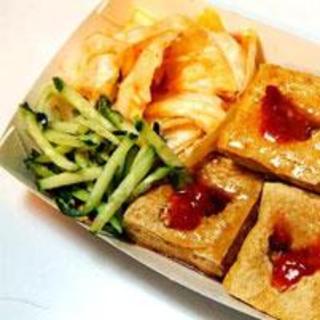
介绍:
Hello and welcome to our weekly feature, Horizons on Newsplus Radio. I'm your host Du Lijun. Snacking is deeply woven into the fabric of daily life in Taiwan. The plethora of snack foods available on the island is a window to local culture. And one of the quickest ways to experience the local flavor of Taiwan is to visit one of the island's many night markets, where visitors can sample authentic Taiwan-style food. A stroll inside any night market is a sure to get your mouth watering and tempt your taste buds. With today's Horizons, we will sample some popular Taiwan snacks as we make our way through some of the most popular night markets in the island. Then we will head to Hangzhou, the provincial capital of east China's Zhejiang; and find out about its bike-sharing system which is the largest of its kind in the world. Please stay tuned.
Anchor: Snacking is deeply woven into the fabric of daily life in Taiwan. The plethora of snack foods available on the island is a window to local culture. And one of the quickest ways to experience the local flavor of Taiwan is to visit one of the island's many night markets, each with a tempting array of mouth-watering delicacies. At each market, visitors can sample a wide selection of snack foods made with locally sourced ingredients. So now, let's follow our reporter Li Jing, as we make our way through some of the most popular night markets in Taiwan.
Reporter:
As dusk falls on the towns and cities of Taiwan, many of the island's locals start to get busy. Some of them are beginning to work, while others are relaxing after a long day. Those starting their day are the people who work in Taiwan's many night markets.
Night markets are great places to shop for bargains and feel the pulse of Taiwan's after-hours life. The markets are bustling with noise and energy, with friendly restaurant owners calling out their menus, stall holders calling out their wares, and crowds of curious onlookers, shoppers and diners mingling together in the night air.
A wide variety of goods including clothing, household items, watches, jewelry, toys and much more are sold at surprisingly low prices. Night markets are also where visitors can sample authentic Taiwan-style food. A stroll inside any night market is a sure to get your mouth watering and tempt your taste buds.
"The stinky tofu here is tasty."
"We are queuing here for da-chang-bao-xia-chang."
Among all the night markets in Taiwan, Feng Chia Night Market in Taichung city may be the biggest. During the weekday evenings, there are usually around 30-thousand to 40-thousand shoppers, while on the weekends or holidays, the number can rise to 100-thousand shoppers.
Feng Chia Night Market is best known for its prices and variety, as well as a lot of snacks, which were invented locally by the owners of these food stalls and restaurants. A lot of innovative snacks now seen in Taiwan's other night markets were originally created at Feng Chia. Among the most favored snacks of the shoppers-turned-foodies are stinky tofu and a Taiwan version of sausage in sticky rice-- da-chang-bao-xia-chang.
Literally translated as "little sausage inside big sausage," this Taiwan snack is a superstar at night markets. It's like a hot dog, but instead of a bread, sticky rice is stuffed inside sausage casing to make an oversized "bun." Then, that's slit open, grilled and a pork sausage is put inside.
Stinky tofu, a popular fermented snack that assaults the nose, but pleases the palate, is also a culinary obsession for the locals in Taiwan. Known affectionately as the blue cheese of tofu, stinky tofu can be served grilled, stewed, braised, steamed or deep fried. Each method has a distinctive odor, taste, texture and color, and an entire afternoon could be spent sampling the different styles.
Though stinky tofu can be found at many night markets in Taiwan, the best place to try this often misunderstood delicacy is on the Shenkeng Old Street in the town of Shenkeng, just a few kilometers east of Taipei.
The locals have been identifying this narrow street with stinky tofu for many years. And after a newly-completed restoration project that spanned three years, the street is now as big a draw as the food. Rows of late-19th-to-early-20th-century red brick shops with lattice windows, hanging eaves, arcade-style walkways, all interspersed with ornate temples or European-Chinese fusion-style mansions, adorn the street. And of course, almost all food vendors are serving one just thing: variations of stinky tofu!
"We serve sticky tofu of different flavors: spicy tofu, garlic-flavored tofu and stewed tofu. The traditional recipe is a stew with fermented tofu cooked for more than 40 minutes in a broth seasoned with 30 different ingredients."
The stewed stinky tofu can also be served with congealed duck's blood and stock broth, which has a pleasant aroma, with a mild peppery bite and varied textures.
The stink caused by the fermentation process, which can take several days to a week to complete. Restaurants are fiercely protective of their recipes for the brine in which they ferment the tofu; it can contain anything from Chinese cabbage and tea leaves to meat, shrimp or milk.
Tales of the origins of stinky tofu are as diverse as the dish itself. Many legends say it was an accidental creation by a careless vender in Qing Dynasty China who left his tofu stewing for an entire season, but found the foul-smelling outcome to be tasty.
Regardless of its true origins, stinky tofu has won converts both inside and outside the Chinese-speaking world and even made CNN's list of the world's most delicious foods in 2011.

